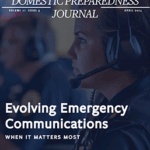- Articles, Communication & Interoperability, Critical Infrastructure, Emergency Management, Public Health, Volunteerism
- Robert J. (Bob) Roller
The new national plan’s goal was to build a doctrinally sound and operationally useful foundation using best practices for plan development.
The planning system required under HSPD-8 was superseded with the promulgation of Presidential Policy Directive 8: National Preparedness (PPD-8) in 2011. PPD-8 enshrined the five mission areas (Prevention, Protection, Mitigation, Response, Recovery) into national doctrine and established an architecture of guidance documents cascading down from the National Preparedness Goal to frameworks and Federal Interagency Operational Plans (FIOPs) for each mission area, to hazard and threat incident annexes, and to both federal agency and other plans. As part of the many other changes PPD-8 brought to the emergency management community, these frameworks, FIOPs, incident annexes, etc., have been updated multiple times since 2011. Subsequent interagency planning led by the Federal Emergency Management Agency (FEMA) includes Nuclear/Radiological, Oil/Chemical, Biological, Food/Agriculture, Space Weather, etc., which all nest under the architecture of guidance documents established by PPD-8 but are informed only by the Response FIOP and include no clear linkages to the other mission areas, stakeholders, or operations.
Plan Development & Content Overview
The major changes tasked to the interagency planning team, co-led by FEMA’s Recovery and Response Directorates with participation from nearly 30 other federal departments and agencies, include:
- Merging the separate Response FIOP and Recovery FIOP, both updated in 2016, into a single document; and
- Ensuring that this combined response and recovery plan reflect the importance of climate change, equity, and significant changes in law, policy, and capabilities since 2016.
The planning team took this challenge head-on and spent nearly three years working through the operational planning steps outlined in Comprehensive Preparedness Guide 101 and the FEMA Operational Planning Manual. The goal was to build a doctrinally sound and operationally useful foundation using best practices for plan development.
The combined Response and Recovery FIOP is the first attempt to merge the NRF and National Disaster Recovery Framework guidance into an operational direction that spans both the response and recovery stakeholder communities. Highlights include the following:
- Recognizing the importance of climate change as an increasing hazard and the importance of ensuring equity in the delivery of response and recovery services;
- Recognizing that response and recovery are concurrent and mutually reinforcing activities, and including recovery stakeholders and considerations into initial response actions;
- Updating the existing terminology and narrative to ensure consistency with current doctrine and policies (e.g., community lifelines and outcome-driven recovery);
- Explaining the link between Emergency Support Functions and Recovery Support Functions, combining their execution during operations;
- Providing functional annexes built by interagency subject matter experts from across the federal government with knowledge in operations, logistics, communications, public information, intelligence, and situational awareness; and
- Employing a concise narrative to make the plan operationally relevant by cutting nearly 470 pages of redundant text from the previous separate FIOPs.
Next Steps
FEMA, in partnership with stakeholders across the emergency management community, will use the FIOP to inform further planning at the lower echelons of the PPD-8 architecture. This effort includes an updated Biological Incident Annex with Toxins Addendum and Nuclear/Radiological Incident Annex (both to be published in 2023), as well as further planning. Additional implementation steps may include exercises and real-world implementation for disasters and other challenges in the future.

Robert J. (Bob) Roller
Robert J. (Bob) Roller serves as the Federal Emergency Management Agency’s (FEMA) National Planning Branch Chief and formerly served as the Planning Division Director within the DHS Office of Policy. He is a frequent contributor to Domestic Preparedness, and the views expressed here do not necessarily represent the views of FEMA or the United States government.
- Robert J. (Bob) Rollerhttps://domprep.com/author/robert-j-bob-roller
- Robert J. (Bob) Rollerhttps://domprep.com/author/robert-j-bob-roller
- Robert J. (Bob) Rollerhttps://domprep.com/author/robert-j-bob-roller
- Robert J. (Bob) Rollerhttps://domprep.com/author/robert-j-bob-roller






